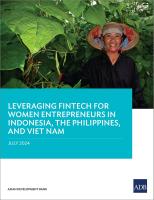Measures that address critically needed financing of microenterprises and those in remote areas remain vital. Photo credit: ADB.
The average effect on job creation of a $1 million investment in SMEs was 10.4 jobs.
Improving access to loans for small and medium-sized enterprises (SMEs) can have a multiplier effect on local economies. The results of an ADB study in Viet Nam show the positive impact of increased financing for SMEs on business growth (i.e., increased productivity and fixed assets) and job creation. Every $1 million lent to SMEs is estimated to create 10 jobs.
Researchers Ngoc Anh Nguyen, Ha-My Bui, Gia-Tan Nguyen, Manfred Kiefer, and Christian Abeleda assessed the impact of access to finance on SME operation and growth, and on the development of local economies in Viet Nam, focusing on job generation. Specifically, the study estimated the economic effects of ADB’s $260 million loan to Vietnam International Bank (VIB), which is intended mainly for on-lending to SMEs, particularly women-led businesses. VIB, one of the country’s largest banks, has an established and growing SME portfolio. About a third of the funds were allocated for mortgage and home improvement lending.
SMEs are the backbone of Viet Nam’s economy, contributing about 45% of the gross domestic product and employing more than 5.6 million workers. They are key to the country’s sustainable development. However, as in other developing countries, getting a loan is a challenge for SMEs in Viet Nam, particularly for women borrowers, because they lack collateral or a guarantor, and banks see them as high-risk borrowers.
“Many SMEs struggle to provide credit institutions with reliable information on solvency and performance, impacting their borrowing chances,” the study said. Instead, they resort to informal sources of financing, such as loans from family and friends.
An analysis of two enterprise surveys suggests that firms with borrowings from formal institutions, such as banks, saw a 54% profit increase, a 15% rise in wage bills, and a marginal 3% growth in cash holdings within a year. They also hired more workers. The average increase is 1.3 direct jobs created per firm. Larger SMEs or those with more than 10 workers were driving the increase in employment. “The higher the firm’s total assets were, the higher its job creation was when borrowing from formal sources,” the study says. SMEs located in highly urbanized areas also created more jobs compared with those in rural areas.
Using these results, the study team calculated the impact of ADB’s loan to VIB. Its projections suggest that funds that went to SME lending created 619 to 3,274 new jobs. The average effect on job creation of a $1 million investment in SMEs was 10.4 jobs. “When focusing on SMEs with over 10 employees, this effect increased to 18.4 jobs,” study says.
These estimates align with the findings of the International Finance Corporation (IFC), which show that $1 million in SME lending in developing countries is associated with an additional 16.3 direct jobs created in 2 years.
The study also looked at other effects of ADB’s lending program with VIB on the local economy. It estimated the loans to SMEs to “lead to an additional average contribution of $768,000 to the fiscal budget and $2.26 million to individual incomes (wages), stimulating the prosperity of the local economy.”
Indirect benefits, such as supply chain effects and jobs indirectly created, are likely but not covered by the study.
While lending to SMEs with more than 10 employees and those in large cities creates more jobs, the study says measures that address critically needed financing of microenterprises and those in remote areas remain vital.
By targeting women borrowers, ADB’s investment support to VIB is expected to serve as an example to other banks and demonstrate that women-led SMEs are a growing and profitable market for financing. The study suggests expanding financial inclusion initiatives to other underserved groups, such as ethnic minorities, persons with low socioeconomic status, and social enterprises, and also supporting capacity-building activities for SMEs.


